Abstract
Polymorphism of human C′3 has been defined by prolonged agarose electrophoresis of fresh serum. At least four, and probably five, alleles have been identified by the electrophoretic mobilities of gene products. Inheritance of three alleles, F1 F, and S, is consistent with the autosomal condominant type. The inheritance of S1 is probably codominant and that of F0·8 is not known. Of the 15 phenotypes predicted by these alleles, eight have been observed.
The allotypes appear to differ in net surface charge at pH 8.6, but show no obvious differences in complement activity, in molecular size, or in binding of Ca++. The concentrations of the two gene products in serum from all known heterozygotes are approximately equal.
The S gene is most common in the three major races of man. The F gene is relatively common in Caucasians, less common in American Negroes, and relatively uncommon in Orientals.
Full text
PDF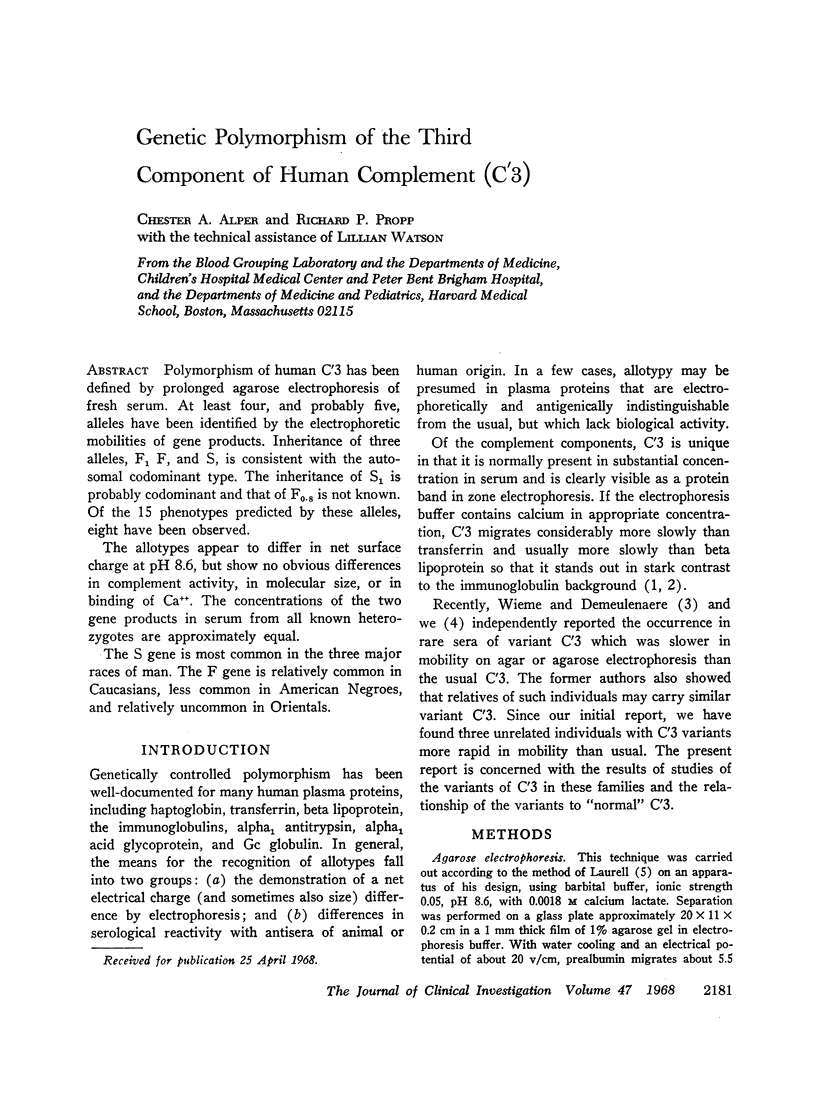


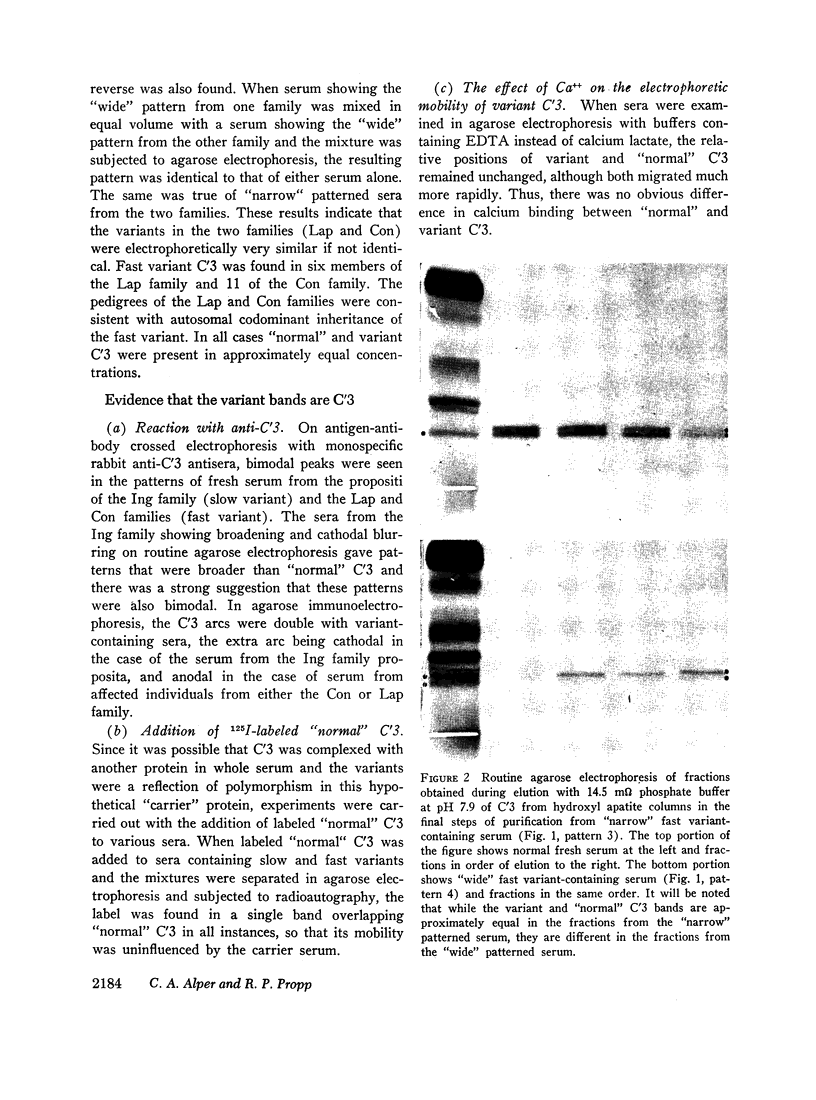
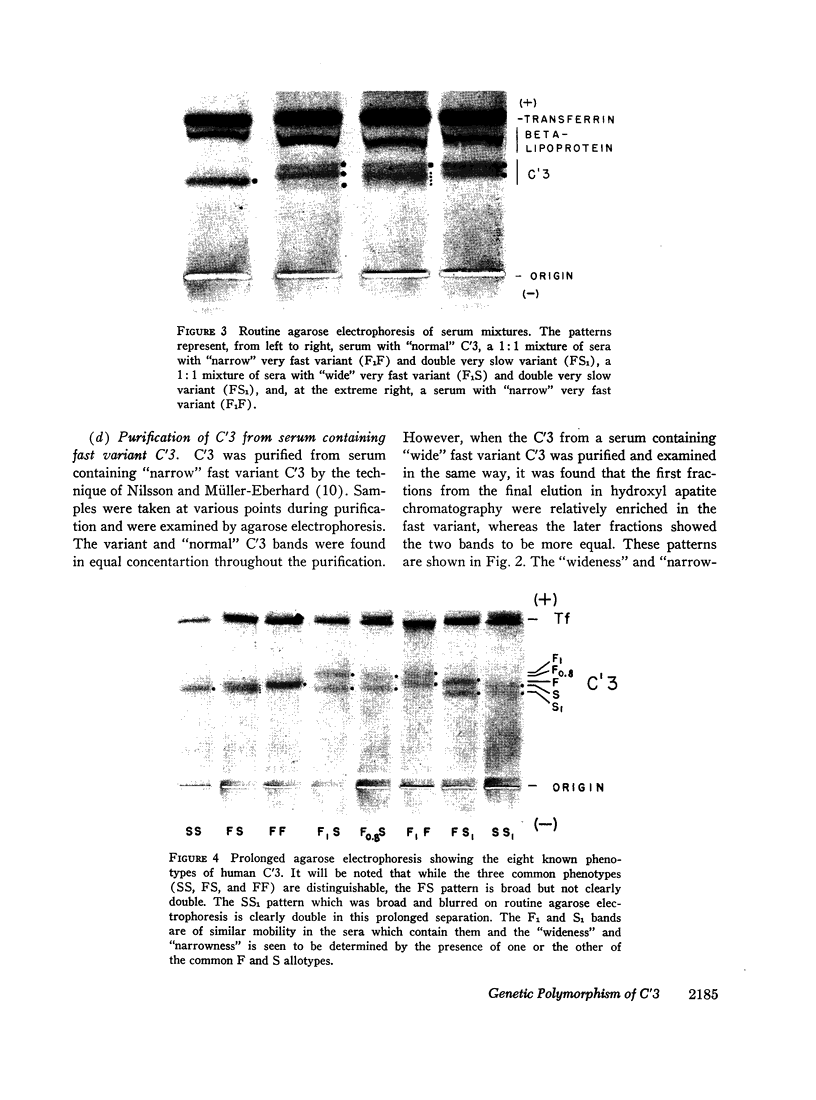


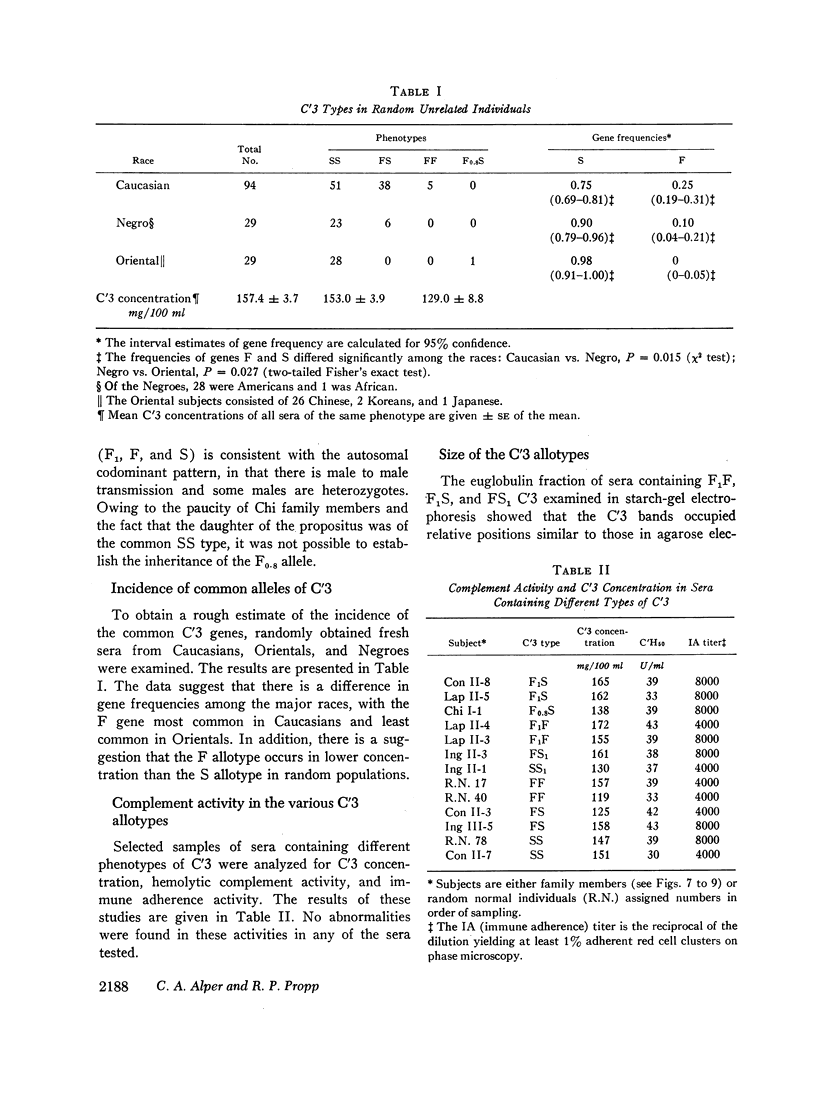
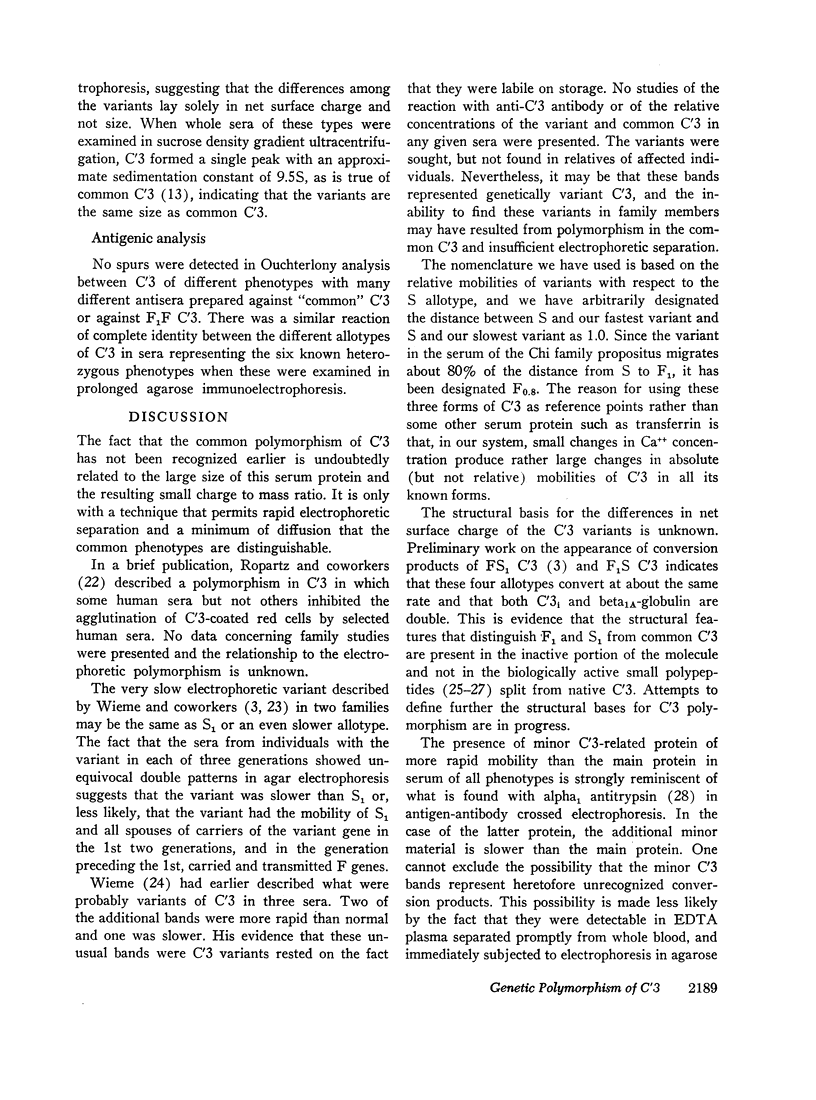

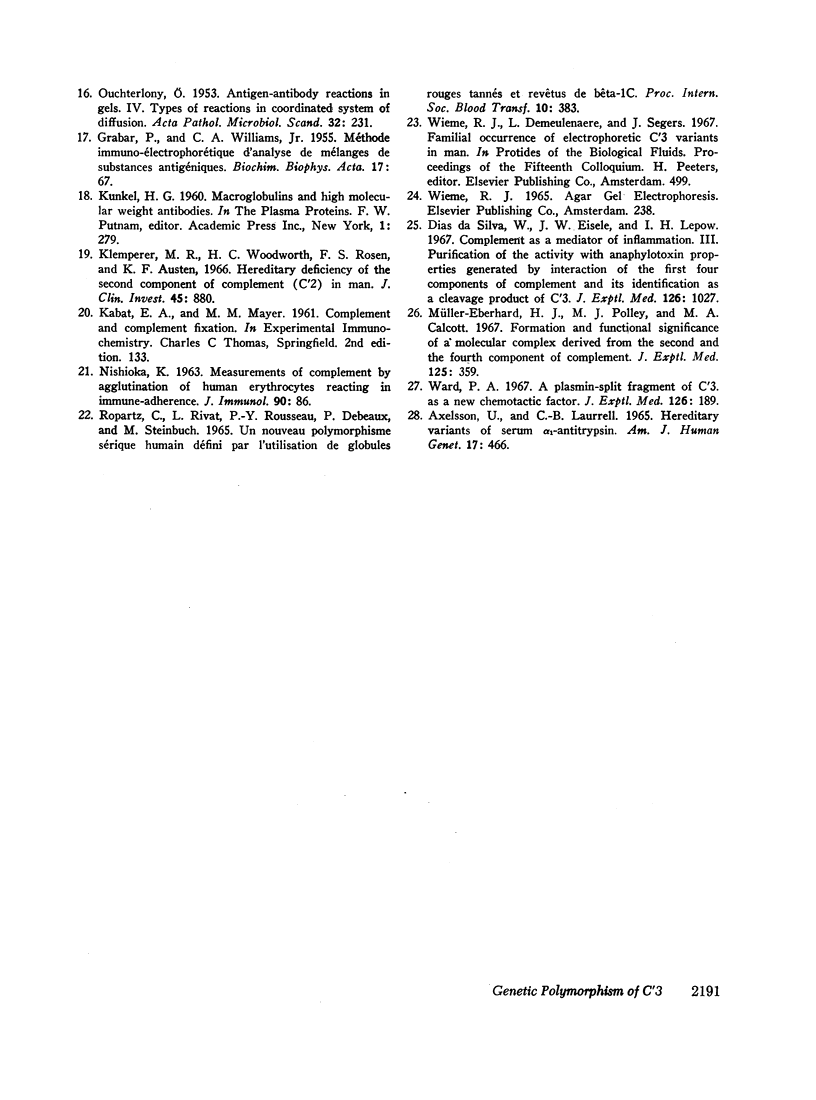
Images in this article
Selected References
These references are in PubMed. This may not be the complete list of references from this article.
- Alper C. A., Rosen F. S. Alper CA, Rosen FS: Studies of the in vivo behavior of human C'3 in normal subjects and patients. J Clin Invest. 1967 Dec;46(12):2021–2034. doi: 10.1172/JCI105691. [DOI] [PMC free article] [PubMed] [Google Scholar]
- Axelsson U., Laurell C. B. Hereditary variants of serum alpha-1-antitrypsin. Am J Hum Genet. 1965 Nov;17(6):466–472. [PMC free article] [PubMed] [Google Scholar]
- GRABAR P., WILLIAMS C. A., Jr Méthode immuno-électrophorétique d'analyse de mélanges de substances antigéniques. Biochim Biophys Acta. 1955 May;17(1):67–74. doi: 10.1016/0006-3002(55)90320-6. [DOI] [PubMed] [Google Scholar]
- Klemperer M. R., Woodworth H. C., Rosen F. S., Austen K. F. Hereditary deficiency of the second component of complement (C'2) in man. J Clin Invest. 1966 Jun;45(6):880–890. doi: 10.1172/JCI105403. [DOI] [PMC free article] [PubMed] [Google Scholar]
- LAURELL C. B. ANTIGEN-ANTIBODY CROSSED ELECTROPHORESIS. Anal Biochem. 1965 Feb;10:358–361. doi: 10.1016/0003-2697(65)90278-2. [DOI] [PubMed] [Google Scholar]
- LAURELL C. B., LAURELL S., SKOOG N. Buffer composition in paper electrophoresis; considerations on its influence, with special reference to the interaction between small ions and proteins. Clin Chem. 1956 Apr;2(2):99–111. [PubMed] [Google Scholar]
- Laurell C. B., Niléhn J. E. A new type of inherited serum albumin anomaly. J Clin Invest. 1966 Dec;45(12):1935–1945. doi: 10.1172/JCI105498. [DOI] [PMC free article] [PubMed] [Google Scholar]
- Laurell C. B. Quantitative estimation of proteins by electrophoresis in agarose gel containing antibodies. Anal Biochem. 1966 Apr;15(1):45–52. doi: 10.1016/0003-2697(66)90246-6. [DOI] [PubMed] [Google Scholar]
- MULLER-EBERHARD H. J., NILSSON U., ARONSSON T. Isolation and characterization of two beta1-glycoproteins of human serum. J Exp Med. 1960 Feb 1;111:201–215. doi: 10.1084/jem.111.2.201. [DOI] [PMC free article] [PubMed] [Google Scholar]
- McFARLANE A. S. Efficient trace-labelling of proteins with iodine. Nature. 1958 Jul 5;182(4627):53–53. doi: 10.1038/182053a0. [DOI] [PubMed] [Google Scholar]
- Müller-Eberhard H. J., Polley M. J., Calcott M. A. Formation and functional significance of a molecular complex derived from the second and the fourth component of human complement. J Exp Med. 1967 Feb 1;125(2):359–380. doi: 10.1084/jem.125.2.359. [DOI] [PMC free article] [PubMed] [Google Scholar]
- NILSSON U. R., MUELLER-EBERHARD H. J. ISOLATION OF BETA IF-GLOBULIN FROM HUMAN SERUM AND ITS CHARACTERIZATION AS THE FIFTH COMPONENT OF COMPLEMENT. J Exp Med. 1965 Aug 1;122:277–298. doi: 10.1084/jem.122.2.277. [DOI] [PMC free article] [PubMed] [Google Scholar]
- NISHIOKA K. Measurements of complement by agglutination of human erythrocytes reacting in immune-adherence. J Immunol. 1963 Jan;90:86–97. [PubMed] [Google Scholar]
- POULIK M. D. Starch gel electrophoresis in a discontinous system of buffers. Nature. 1957 Dec 28;180(4600):1477–1479. doi: 10.1038/1801477a0. [DOI] [PubMed] [Google Scholar]
- Ropartz C., Rivat L., Rousseau P. Y., Debeaux P., Steinbuch M. Un nouveau polymorphisme sérique humain défini par l'utilisation de globules rouges tannés et revêtus de bêta-1C. Bibl Haematol. 1965;23:383–384. [PubMed] [Google Scholar]
- SMITHIES O. An improved procedure for starch-gel electrophoresis: further variations in the serum proteins of normal individuals. Biochem J. 1959 Mar;71(3):585–587. doi: 10.1042/bj0710585. [DOI] [PMC free article] [PubMed] [Google Scholar]
- Ward P. A. A plasmin-split fragment of C'3 as a new chemotactic factor. J Exp Med. 1967 Aug 1;126(2):189–206. doi: 10.1084/jem.126.2.189. [DOI] [PMC free article] [PubMed] [Google Scholar]
- Wieme R. J., Demeulenaere L. Genetically determined electrophoretic variant of the human complement component C'3. Nature. 1967 Jun 3;214(5092):1042–1043. doi: 10.1038/2141042a0. [DOI] [PubMed] [Google Scholar]
- da Silva W. D., Eisele J. W., Lepow I. H. Complement as a mediator of inflammation. 3. Purification of the activity with anaphylatoxin properties generated by interaction of the first four components of complement and its identification as a cleavage product of C'3. J Exp Med. 1967 Dec 1;126(6):1027–1048. doi: 10.1084/jem.126.6.1027. [DOI] [PMC free article] [PubMed] [Google Scholar]










